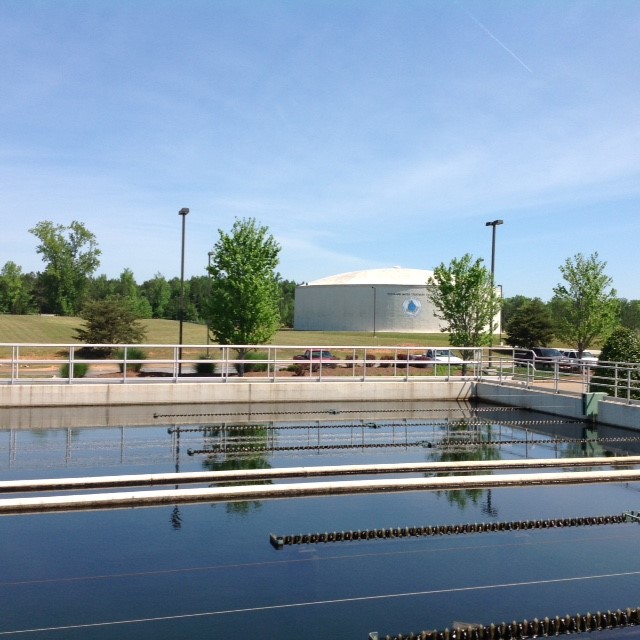WATER TREATMENT
Producing clean, safe drinking water for HCWA customers
The HCWA owns two drinking water treatment facilities, the Tussahaw and Towaliga Plants.
The Tussahaw Water Treatment Plant has a production capacity of 16.1 million gallons per day (MGD), with infrastructure in place to expand capacity another 16.1 MGD if necessary in the future.

In fact, the Authority has already designed the Phase II expansion of the Tussahaw Plant, so plans for construction are in place when such additional production capacity is needed.

The Towaliga Water Treatment Facility has a rated capacity for treatment of 24.4 MGD, and a (treated) water pumping rated capacity of 30 MGD.
Once raw water is treated at either the Tussahaw or Towaliga Plants, the finished drinking water is pumped to storage facilities and then distributed throughout the water distribution network, into the homes and businesses of more than 50,000 HCWA customers.
DRINKING WATER STORAGE
The network of elevated and ground storage tanks
HCWA owns four ground storage tanks with an aggregate storage capacity for treated water of 11.3 million gallons. The Authority also owns nine elevated storage tanks with an aggregate storage capacity for treated water of 6.7 million gallons. In addition, HCWA has 6.0 million gallons of water storage at the clear well of its Tussahaw Plant, and another 5.5 million gallons of total clear well water storage capacity at the Towaliga Facility.
Summary of Storage Tank Capacity:
|
Tank Type |
Capacity |
|
4 ground tanks |
11.3 Million |
|
9 elevated tanks |
6.7 Million |
|
Tussahaw Clear Well |
6.0 Million |
|
Towaliga Clear Well |
5.5 Million |
|
Total: |
29.5 Million |
DRINKING WATER DISTRIBUTION
The vast underground water mains and lines of the HCWA system
HCWA's water distribution network consists of approximately 1,300 miles of pipelines, ranging in size from 6 inches to 48 inches in diameter. Most of the transmission and distribution system pipelines are made of ductile iron. Approximately 25% of the pipelines have been in service for nearly 20 years, with the oldest pipelines installed more than 30 years ago.
Water Quality Lab
Assuring safe, clean drinking water for HCWA customers
.jpg)
HCWA’s Tussahaw and Towaliga Water Treatment Plants are operational 24 hours per day, 7 days per week, and 365 days per year, by trained and state-certified plant operators. In addition, the Authority's Tussahaw Water Treatment Plant houses HCWA’s Water Quality Lab, which features the latest technology in monitoring equipment, to assure customers that their water has been treated to the highest standards for quality and safety in the industry.
Maintaining HCWA’s drinking water distribution system involves routine sampling, flushing of water lines, and ongoing maintenance of water storage tanks. The Authority’s staff takes a minimum of 120 samples per month from throughout the distribution system, which in turn are tested in the state-certified, bacteriological Water Quality Lab.
HCWA’s Water Quality Lab has won the Water Lab of the Year Award in 2017, 2015 and 2011 as presented by the Georgia Association of Water Professionals (GAWP).
Monitored Flow at the Tussahaw Dam
Raw water quality is important to the HCWA, so the following table is being included on this Web site to provide real time data of the quantity and quality of the water being released to flow downstream from the Tussahaw Reservoir.
CAPITAL IMPROVEMENTS
Planned upgrades to the award-winning HCWA system
Over the last few years, HCWA has implemented several capital improvements according to the master plan of its water system. Some of those highlights include:
-
Designing the Phase II expansion of the Tussahaw Water Treatment Plant.
-
Completing approximately 50 miles of water distribution line extensions.
-
Addressing approximately 12 projects of water main and water line rehabilitation.
-
Monitoring both chemical and biological constituents and parameters of water bodies, as part of the Watershed Assessment and Stormwater Phase II project.
-
Constructing additional boat ramps at the Tussahaw and Cole (Upper Towaliga) Reservoirs for public access.
-
Construction additional water storage tanks to increase system storage capacity.
